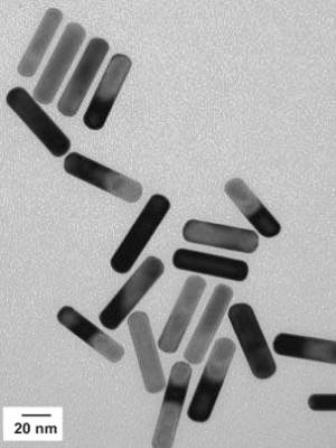ScienceDaily (May 5, 2009) — It has long been known that heat is an effective weapon against tumor cells. However, it's difficult to heat patients' tumors without damaging nearby tissues.
Now, MIT researchers have developed tiny gold particles that can home in on tumors, and then, by absorbing energy from near-infrared light and emitting it as heat, destroy tumors with minimal side effects.

Such particles, known as gold nanorods, could diagnose as well as treat tumors, says MIT graduate student Geoffrey von Maltzahn, who developed the tumor-homing particles with Sangeeta Bhatia, professor in the Harvard-MIT Division of Health Sciences and Technology (HST) and in the Department of Electrical Engineering and Computer Science, a member of the David H. Koch Institute for Integrative Cancer Research at MIT and a Howard Hughes Medical Institute Investigator.
Von Maltzahn and Bhatia describe their gold nanorods in two papers recently published in Cancer Research and Advanced Materials. In March, von Maltzahn won the Lemelson-MIT Student Prize, in part for his work with the nanorods.
Cancer affects about seven million people worldwide, and that number is projected to grow to 15 million by 2020. Most of those patients are treated with chemotherapy and/or radiation, which are often effective but can have debilitating side effects because it's difficult to target tumor tissue.
With chemotherapy treatment, 99 percent of drugs administered typically don't reach the tumor, said von Maltzahn. In contrast, the gold nanorods can specifically focus heat on tumors.
"This class of particles provides the most efficient method of specifically depositing energy in tumors," he said.
Wiping out tumors
Gold nanoparticles can absorb different frequencies of light, depending on their shape. Rod-shaped particles, such as those used by von Maltzahn and Bhatia, absorb light at near-infrared frequency; this light heats the rods but passes harmlessly through human tissue.
In a study reported in the team's Cancer Research paper, tumors in mice that received an intravenous injection of nanorods plus near-infrared laser treatment disappeared within 15 days. Those mice survived for three months with no evidence of reoccurrence, until the end of the study, while mice that received no treatment or only the nanorods or laser, did not.
Once the nanorods are injected, they disperse uniformly throughout the bloodstream. Bhatia's team developed a polymer coating for the particles that allows them to survive in the bloodstream longer than any other gold nanoparticles (the half-life is greater than 17 hours).
In designing the particles, the researchers took advantage of the fact that blood vessels located near tumors have tiny pores just large enough for the nanorods to enter. Nanorods accumulate in the tumors, and within three days, the liver and spleen clear any that don't reach the tumor.
During a single exposure to a near-infrared laser, the nanorods heat up to 70 degree Celsius, hot enough to kill tumor cells. Additionally, heating them to a lower temperature weakens tumor cells enough to enhance the effectiveness of existing chemotherapy treatments, raising the possibility of using the nanorods as a supplement to those treatments.
The nanorods could also be used to kill tumor cells left behind after surgery. The nanorods can be more than 1,000 times more precise than a surgeon's scalpel, says von Maltzahn, so they could potentially remove residual cells the surgeon can't get.
Finding tumors
The nanorods' homing abilities also make them a promising tool for diagnosing tumors. After the particles are injected, they can be imaged using a technique known as Raman scattering. Any tissue that lights up, other than the liver or spleen, could harbor an invasive tumor.
In the Advanced Materials paper, the researchers showed they could enhance the nanorods' imaging abilities by adding molecules that absorb near-infrared light to their surface. Because of this surface-enhanced Raman scattering, very low concentrations of nanorods - to only a few parts per trillion in water [gf1]- can be detected.
Another advantage of the nanorods is that by coating them with different types of light-scattering molecules, they can be designed to simultaneously gather multiple types of information - not only whether there is a tumor, but whether it is at risk of invading other tissues, whether it's a primary or secondary tumor, or where it originated.
Bhatia and von Maltzahn are looking into commercializing the technology. Before the gold nanorods can be used in humans, they must undergo clinical trials and be approved by the FDA, which von Maltzahn says will be a multi-year process.
Other authors of the Advanced Materials paper are Andrea Centrone, postdoctoral associate in chemical engineering; Renuka Ramanathan, undergraduate in biological engineering; Alan Hatton, the Ralph Landau Professor of Chemical Engineering; and Michael Sailor and Ji-Ho Park of the University of California at San Diego.
Park and Sailor are also authors of the Cancer Research paper, along with Amit Agrawal, former postdoctoral associate in HST; and Nanda Kishor Bandaru and Sarit Das of the Indian Institute of Technology Madras.
The research was funded by the National Institutes of Health, the Whitaker Foundation and the National Science Foundation. Nanopartz Inc. supplied gold nanoparticles, gold nanowires and the precursor gold nanorods used in this work.
Journal references:
- Geoffrey von Maltzahn, Ji-Ho Park, Amit Agrawal, Nanda Kishor Bandaru, Sarit K. Das, Michael J. Sailor, and Sangeeta N. Bhatia. Computationally Guided Photothermal Tumor Therapy Using Long-Circulating Gold Nanorod Antennas. Cancer Research, 2009; 69 (9): 3892 DOI: 10.1158/0008-5472.CAN-08-4242
- Geoffrey von Maltzahn, Andrea Centrone, Ji-Ho Park, Renuka Ramanathan, Michael J. Sailor, T. Alan Hatton, Sangeeta N. Bhatia. SERS-Coded Gold Nanorods as a Multifunctional Platform for Densely Multiplexed Near-Infrared Imaging and Photothermal Heating. Advanced Materials, 2009; NA DOI: 10.1002/adma.200803464
